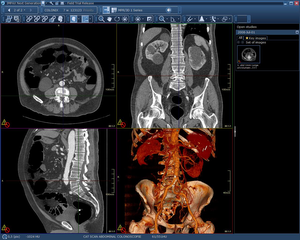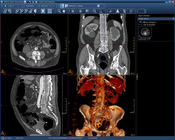Information
- Publication Type: PhD-Thesis
- Workgroup(s)/Project(s):
- Date: January 2013
- Date (End): January 2013
- TU Wien Library:
- 1st Reviewer: Eduard Gröller
- 2nd Reviewer: Univ. Doz. Dr. med. univ. Stefan Wolfsberger
- Rigorosum: 1. February 2013
- First Supervisor: Eduard Gröller
Abstract
Volumetric imaging is widely used in medicine and life sciences allowing to gain insight into otherwise opaque objects. Volumetric images do not unveil their content in a direct way due to their spatial structure. Therefore a variety of computational methods are used for visualization and processing which allow to explore and analyze the data.Analysis and exploration of the data is usually performed in an interactive way either manually or with support of semi-automatic algorithms. It is crucial for an efficient completion of the task that the system performs interactively and responsively. Thus, software supporting the user in an effective way relies on three basic requirements. First, the system must deliver feedback in a short period of time. Second, results of any computation must be presented or visualized in a way that the user can efficiently recognize the important information. Third, the user must be able to efficiently control, initialize or adjust the algorithm through a suitable user interface. In this thesis four approaches are presented which aim to solve different aspects of the problem of enabling interactivity in analysis and exploration of volumetric image data.
The first presented project studies the design of an application which has strict limitations concerning the user interface due to the application environment which requires almost a hands free interaction. The problem is approached by the development of efficient and robust visualization which makes adjustments needless, and by the development of sophisticated interaction patterns which reduce the needed interface to the minimum.
The second project focuses on methods which optimize a computationally intensive feature detection task that can be used in an interactive scenario which requires the algorithm to produce results in just a few seconds. To achieve this goal the probabilistic boosting tree classification algorithm is extended and optimized for runtime and memory efficiency.
The third and the fourth project focus on the interactive exploration of large image and object collections. Two approaches are presented for this problem area. For the retrieval of neuronal objects by similarity, measures for different neuronal substructures have been developed which are able to perform efficiently on large amounts of data. For retrieval of images and objects by local means such as neighborhood, overlap, local image expression and local image similarity a sophisticated updatable high performance index structure has been developed. The index allows to store local properties of volumetric data in a space efficient way and to retrieve this data with low latency.
The presented projects demonstrate that the challenge of achieving interactivity often is the development of methods which allow to balance processing speed with result quality. Furthermore it is shown that time performance is not the only property which needs to be respected,result presentation as well as interaction patterns deserve similar attention and contribute greatly to an interactive user experience.
Additional Files and Images
Weblinks
No further information available.BibTeX
@phdthesis{Schulze_Florian_2013_CMI,
title = "Computational Methods enabling Interactivity in Analysis and
Exploration of Volumetric Images",
author = "Florian Schulze",
year = "2013",
abstract = "Volumetric imaging is widely used in medicine and life
sciences allowing to gain insight into otherwise opaque
objects. Volumetric images do not unveil their content in a
direct way due to their spatial structure. Therefore a
variety of computational methods are used for visualization
and processing which allow to explore and analyze the data.
Analysis and exploration of the data is usually performed in
an interactive way either manually or with support of
semi-automatic algorithms. It is crucial for an efficient
completion of the task that the system performs
interactively and responsively. Thus, software supporting
the user in an effective way relies on three basic
requirements. First, the system must deliver feedback in a
short period of time. Second, results of any computation
must be presented or visualized in a way that the user can
efficiently recognize the important information. Third, the
user must be able to efficiently control, initialize or
adjust the algorithm through a suitable user interface. In
this thesis four approaches are presented which aim to solve
different aspects of the problem of enabling interactivity
in analysis and exploration of volumetric image data. The
first presented project studies the design of an application
which has strict limitations concerning the user interface
due to the application environment which requires almost a
hands free interaction. The problem is approached by the
development of efficient and robust visualization which
makes adjustments needless, and by the development of
sophisticated interaction patterns which reduce the needed
interface to the minimum. The second project focuses on
methods which optimize a computationally intensive feature
detection task that can be used in an interactive scenario
which requires the algorithm to produce results in just a
few seconds. To achieve this goal the probabilistic boosting
tree classification algorithm is extended and optimized for
runtime and memory efficiency. The third and the fourth
project focus on the interactive exploration of large image
and object collections. Two approaches are presented for
this problem area. For the retrieval of neuronal objects by
similarity, measures for different neuronal substructures
have been developed which are able to perform efficiently on
large amounts of data. For retrieval of images and objects
by local means such as neighborhood, overlap, local image
expression and local image similarity a sophisticated
updatable high performance index structure has been
developed. The index allows to store local properties of
volumetric data in a space efficient way and to retrieve
this data with low latency. The presented projects
demonstrate that the challenge of achieving interactivity
often is the development of methods which allow to balance
processing speed with result quality. Furthermore it is
shown that time performance is not the only property which
needs to be respected,result presentation as well as
interaction patterns deserve similar attention and
contribute greatly to an interactive user experience.",
month = jan,
address = "Favoritenstrasse 9-11/E193-02, A-1040 Vienna, Austria",
school = "Institute of Computer Graphics and Algorithms, Vienna
University of Technology ",
URL = "https://www.cg.tuwien.ac.at/research/publications/2013/Schulze_Florian_2013_CMI/",
}


 Thesis
Thesis
